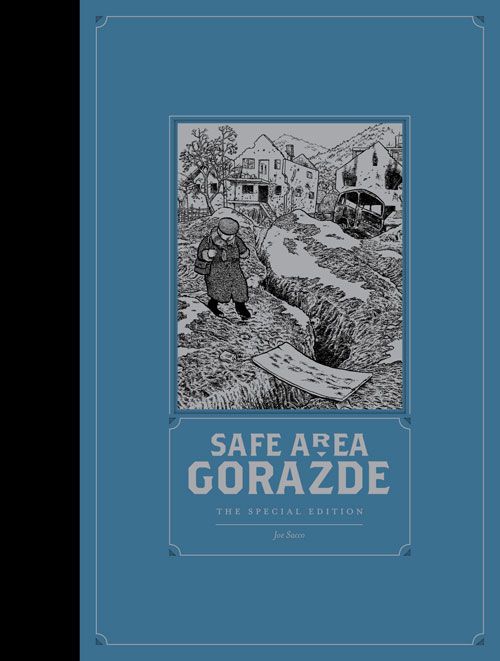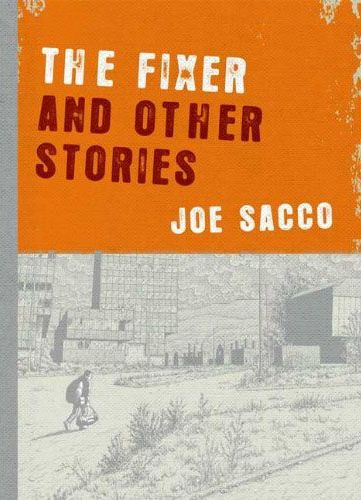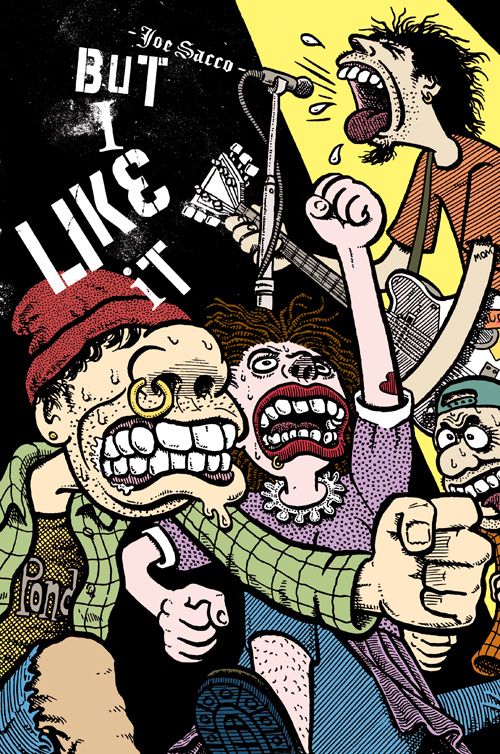Comics College is a monthly feature where we provide an introductory guide to some of the comics medium’s most important auteurs and offer our best educated suggestions on how to become familiar with their body of work.
This month we're examining the bibliography of one of the more interesting and significant cartoonists to come out of the alt-comix movement of the 1980s and '90s, Joe Sacco.
Why he's important
There's not many cartoonists in this day and age who can actually say they invented an entirely new genre virtually from scratch. Sacco can. Oh, sure, there were cartoonists poking at the idea of comics journalism before Sacco (most notably Spain), but it wasn't until Palestine that the idea of using comics as a form of journalism -- to relay information and tell important, human-interest stories about events happening around the world, came to the fore. Few have followed Sacco down his chosen path -- perhaps out of a fear of putting oneself on the front line -- but the fact is you can draw a direct line from works like Safe Area Gorazde to recent books like How to Understand Israel in 60 Days, AD: After the Deluge and even Ward Sutton's book reviews. Sacco made it OK for cartoonists to explore nonfiction (that wasn't necessarily autobiographical).
The novelty of Sacco's particular niche tends to obscure some of his rather significant qualities as an artist and storyteller. He's an endlessly inventive cartoonist, capable of creating incredible detailed vistas that give readers a definitive sense of place and time. He's capable of moving from near-photo-like realism to a Basil Wolverton-ish exaggeration that can perfectly capture, say, a sweaty, crowded night club. In short, he's an amazingly gifted craftsman, one of the best people making comics out there today.
Where to start
Safe Area Gorazde, Sacco's story about a small, mostly Muslim town that somehow managed to survive the Bosnian War despite being surrounded by Serb forces, was the book that finally broke Sacco out into the wider public (and helped kick-start the graphic novel boom). It arguably remains Sacco's best work to date (though some may cite his latest, Footnotes in Gaza, as a contendor; more on that in a minute) and is the best starting point for any newcomer. The good news is that Fantagraphics has just released a Special Edition of the book, featuring reference photos, essays, updates on the people Sacco chronicles and more. Fanta has done a good job filling their Special Edition books with choice extras, so I'd say it's probably worth ponying up the extra scratch for this version.
From there you should read
The Fixer and Other Stories is a good next stop on our journey, as it continues Sacco's examination of the Bosnian War with a trio of compelling stores: the title tale, about a former soldier who helps correspondents find the headline-grabbing news they want; Soba, about a warrior-poet soldier who finds it difficult to adjust to peacetime; and the brilliant Christmas With Karadzic, wherein he and other reporters go out on a desperate attempt to meet and interview a known war criminal.
Safe Area Gorazde was the book that won Sacco national attention, but it was Palestine that first pointed the way towards what could be done by mixing comics and journalism together. As the title suggests, Sacco makes no bones about where he stands on the Mideast debate, and while he takes care to not present the Israelis as devils or the Palestinians as saints, there are no doubt those who will balk at anything that even suggests that Israel is unjustified in their use of force. It's not as strong a book as Safe Area -- you can sense the author getting a feel for which tone the material should take, starting with an exaggerated self-deprecation before settling down into a more straightforward serious vibe. Again, I'd recommend going with the Special Edition version, which contains a number of lovely extras like sketchbook samples.
If anything Footnotes in Gaza, Sacco's most recent book is even angrier than Palestine in tone, though it's far from a polemic. Covering two barely mulled-over events from 1956, he draws deep connections between the injustices committed more than fifty years ago and the abuses heaped on the people living in the Gaza Strip today, detailing a shameful legacy. It's nothing less than a tour de force, as Sacco weaves effortlessly back and forth between the past and present and relays countless stories almost lost to the ages.
Further reading
When he doesn't have his reporter's cap on, Sacco likes to indulge in his cartoony, satirical side, a fact most evident in But I Like It a compendium of rock-oriented, mostly humorous strips, the most notable being In the Company of Long Hair, which recounts Sacco's adventures as a roadie and t-shirt seller for the punk rock band the Miracle Workers during their European tour. There's also a self-depricating essay on his love affair with the Rolling Stones, some funny one-page gags about the state of the music industry circa 1991, and some early poster art, not to mention a CD of the Miracle Workers live in concert.
Notes From a Defeatist collects all the material from Sacco's Fantagraphics-published pamphlet series, Yahoo, including In the Company of Long Hair. Despite that repetition, the book is worth getting, mainly for such pieces as the excellent More Women, More Children, More Quickly, about his Mother's harrowing experiences in Malta during World War II , and How I Loved the War, a chronicle of his obsession with the first Gulf War. Both stories point the way towards the more serious, political comics he would eventually produce.
Ancillary material
Sacco contributed a powerful story of female refugees entitled Chechen War, Chechen Women, in the Mia Kirshner-edited project I Live Here. In fact, Sacco's done a number of compelling stories for a variety of magazines, most of which have yet to be collected in one volume. Here's hoping that changes soon.
Sacco was also a regular collaborator with Harvey Pekar on Pekar's American Splendor series, a sampling of which you can get via the Music Comics collection from Dark Horse.
Folks who want to hear about Sacco's personal history and read what he has to say on various comics and journalism related topics should check out a very nice interview with Sacco in the Comics Journal Special Edition Winter 2002. I understand there's also a notable interview with him in the upcoming Comics Journal Issue #301.
Avoid
I don't know that I'd say you should necessarily avoid this book, but Spotlight on the Genius That Is Joe Sacco, a 57-page one shot collecting his early, early work (mostly culled from the pages of anthologies like Weirdo) is definitely not the place for newcomers to begin, as the focus is on more slapstick and satirical material, particularly on the vagaries of the corporate, work-a-day world. It's not Sacco's best work, certainly, and the fact that some stories are repeated in Notes From A Defeatist make it only that much less essential. Save it for when you've indulged in everything else he's done and still want more.




